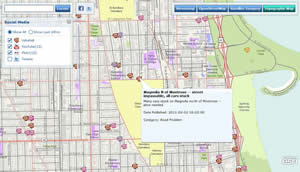ArcWatch: Your e-Magazine for GIS News, Views, and Insights
March 2011
When Snow Means Slumping Sales
How Retailers Can Regain Revenues after Storms Interrupt Business

Winter storms brought many cities such as Chicago, to a standstill, leaving retailers with empty stores and an eye on how to entice customers back after the snow melted.
This winter's ferocious storms wreaked havoc in the United States and the United Kingdom. In the United States, storms battered the Midwest, Northeast, and even parts of the South. Across the pond, last December was the coldest on record for the last 100 years. The snow, ice, and freezing temperatures did more than close roads and schools and suspend flights at airports. In both countries some retailers were left at a loss—for sales.
The storms, which heaped heavy snow and ice on portions of 30 states including Illinois, Maryland, Connecticut, Texas, and Maine, forced many businesses to close. "The retail market is always very aware of Mother Nature," says Simon Thompson, director of commercial solutions, Esri. "Unfortunately, this winter the snow had a negative impact on sales."
Thompson's comment parallels the International Council of Shopping Centers' weekly tally, which shows that retail sales dropped 1.2 percent on a week-over-week basis in January 2011, with a net loss from the same period the year before.
How can businesses rally? Savvy retailers know that being in constant contact with customers is important. This holds especially true when consumers may need coaxing to venture out of their warm houses to do a little shopping.
Communicating with consumers via mailers, letters, social media, and even phone calls to let them know not only when a store is closed but also when it reopens is important to attract and retain loyal customers.

After the snow clears, retailers can use Business Analyst Online to find city blocks with a high percentage of families with children and then perform a drive time analysis of the market area to plan a campaign to increase traffic to their stores.
Esri's online and mobile GIS applications, such as Esri Business Analyst Online (BAO) and BAO for iOS, a free app that runs on iPhone or iPad, instantly provide insight about customers and can help retailers through tough times. The BAO solution allows retailers to see exactly where their customers are located and analyze their lifestyle characteristics, purchasing behavior, and demographic profile. This knowledge can then be used to create mailing lists and special offers that are fine-tuned to match those customers' needs and wants. Profiling existing customers helps businesses find other consumers like them.
A longtime user of Esri technology, Edens & Avant, headquartered in Columbia, South Carolina, understands the importance of retailers keeping in constant contact with customers. The company successfully owns, operates, and develops community-oriented shopping centers in large cities throughout the East Coast. It manages more than 130 centers in 14 states, leasing space to regional and national retailers such as Fresh Market, Whole Foods, Publix, Starbucks, and Target. Edens & Avant uses BAO extensively to identify new markets and help retailers find the right shopping center location.
"GIS can be used to regain profits lost during a business interruption like so many retailers have experienced due to bad weather," says David Beitz, director of GIS for Edens & Avant. BAO helps users create trade areas based on customer counts or sales around their stores. Beitz recommends using the solution to geocode customer addresses (accessible from store credit or loyalty cards) onto a map to create a trade area showing the highest concentration of sales volume closest to each store. The addresses of customers that are found inside the target areas can be exported from BAO in spreadsheet form and used to generate mailing rosters, call lists, or e-mail campaigns. This can save time and money by allowing the retailer to hone in on a particular area for a mailing, for example, instead of blanketing several ZIP Code regions or an even larger area.
Next, Beitz recommends using a service to obtain residential addresses of people in the trade area who match the retailer's customer profile.
Thompson agrees. "Do all you can to attract those customers back into your store," he says. "Think about mailing a coupon to attract as many customers as possible to the store after it reopens. A coupon adds perceived value and gives them a time constraint. With some simple steps like this, the profits lost during business closures can be regained and, in some cases, attract new customers."
Esri Tapestry Segmentation data helps retailers find other customers who fit their shoppers' profiles. By classifying US residential neighborhoods into 65 unique market segments based on socioeconomic and demographic characteristics, customer data can be analyzed to understand customers better. Retailers can append their own customer data to find which of the segments their customers fit into, such as High Hopes, areas filled with young households striving for the American dream, and Suburban Periphery I, which contains mostly married-couple families in lower-density suburban areas that are expanding. (Find the profile of your own neighborhood.) This customer profiling can be used to tailor-fit marketing messages to pique the interest of customers.
Once this is accomplished, Beitz also suggests using social media to let customers know about any special offers by e-mailing them directly and posting on Facebook and Twitter. "To go one step further, I would take the location information from the GIS trade area study and use that for a [Google] AdWords campaign [on Facebook]," Beitz says. "A Facebook/AdWords campaign lets the retailer specify location and demographic data in targeting customers. By learning the spatial attributes and the exact demographics of core customers, a lot of money can be saved by targeting ad campaigns to a narrow group via traditional mailings as well as online."
For more information on how GIS is used in retail business, visit esri.com/retail.